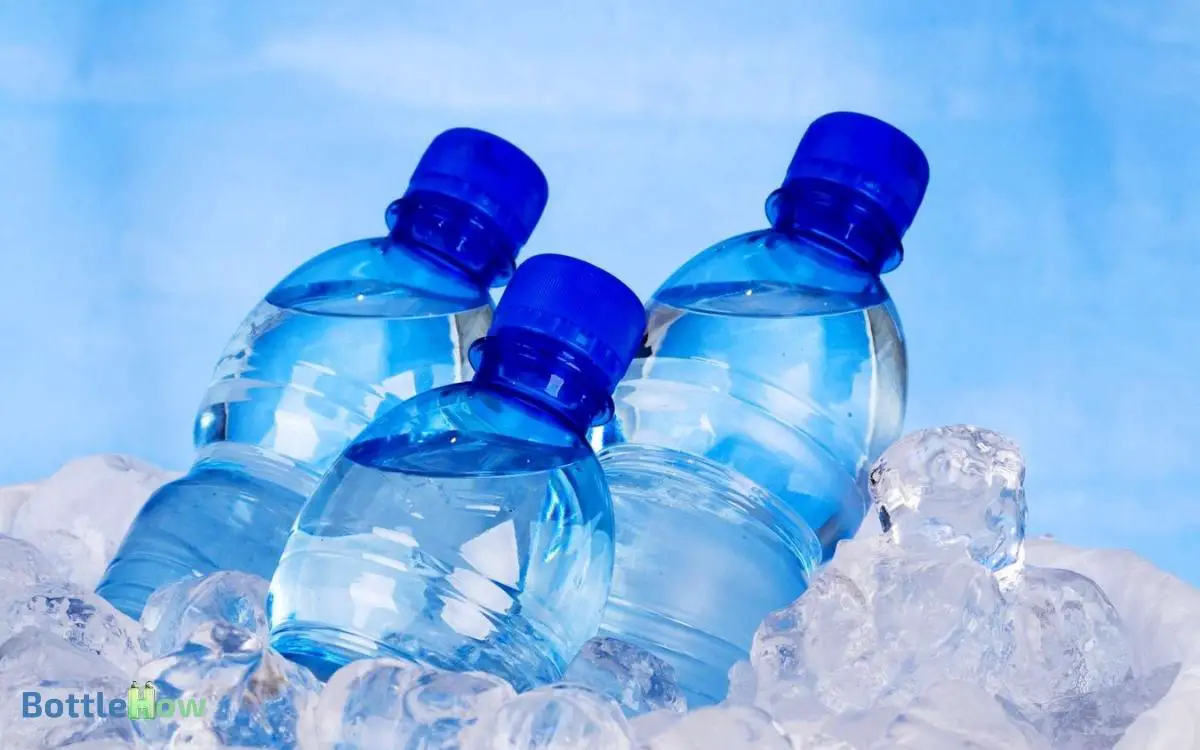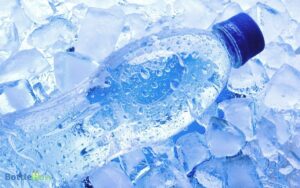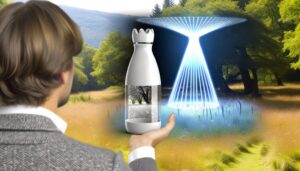Cold Water Bottle Turns to Ice: Supercooling!
You can turn a cold water bottle into ice instantly due to the fascinating phenomenon called supercooling.
When you cool pure water below its freezing point without letting it solidify, it stays in a liquid state because it lacks nucleation points.
To achieve this, place a purified water bottle in the freezer for about two hours, ensuring no disturbances.
When removed and slightly tapped or shaken, the water rapidly turns to ice. This process relies on a delicate balance of temperature and purity.
Want to know more about safely performing this experiment and its practical applications? Keep going.

Key Takeaways
What Is Supercooling?
Supercooling is the process where a liquid is cooled below its freezing point without it becoming solid.
When you supercool water, it remains in a liquid state even though it’s at a temperature where you’d expect it to freeze.
This happens because the water lacks nucleation points, which are necessary for ice crystals to form.
You can achieve supercooling by cooling pure water slowly and carefully, avoiding any disturbances.
It’s a fascinating phenomenon that occurs under specific conditions, and understanding it can help you appreciate why a seemingly normal water bottle can suddenly turn to ice.
By grasping the concept of supercooling, you’ll gain insight into the delicate balance of temperature and purity required to keep water in a liquid state below freezing.
The Science Behind It
Understanding the science behind supercooling involves examining the molecular dynamics that prevent ice crystal formation despite sub-freezing temperatures.
When water is cooled below its freezing point without solidifying, it remains in a metastable state. The molecules are moving slowly but haven’t yet formed the rigid structure of ice.
This happens because ice nucleation, the process where water molecules lock into a crystalline pattern, requires a nucleation site, which might be absent in pure water.
Here’s a breakdown to clarify:
| Concept | Description | Example |
|---|---|---|
| Metastable State | Water below freezing point, still liquid | Supercooled water bottle |
| Molecular Dynamics | Slow-moving molecules | Water molecules at 32°F |
| Ice Nucleation | Formation of ice crystals | Ice forming on impurities |
| Nucleation Site | Starting point for crystal formation | Dust particle in water |
| Freezing Point | Temperature at which water normally freezes | 32°F (0°C) |
Understanding these dynamics helps you grasp why supercooling occurs.
Necessary Conditions
To understand why a cold water bottle turns to ice, you’ll need to take into account three key factors.
First, the temperature must be below the freezing point. Additionally, supercooling occurs, and the water’s purity plays an essential role in this transformation.
Temperature Below Freezing Point
For a cold water bottle to turn into ice, the temperature must drop below the freezing point of water, which is 32 degrees Fahrenheit or 0 degrees Celsius. When the temperature drops below this threshold, the water inside the bottle begins to freeze, forming ice crystals that gradually spread throughout the liquid. However, in some cases, supercooled water can remain in liquid form even below the freezing point until it is disturbed, causing it to freeze instantly. This phenomenon can sometimes contribute to the coldest water bottle suction issue, where pressure changes inside the bottle make it difficult to open or cause unexpected suction effects.
You need to make sure this condition is met for the water molecules to slow down and form solid ice.
Here’s a quick breakdown of the critical temperatures and their significance:
| Temperature (°F) | Temperature (°C) | State of Water |
|---|---|---|
| 32 | 0 | Freezing Point |
| Below 32 | Below 0 | Potential to Freeze |
| Above 32 | Above 0 | Liquid |
When the temperature is below freezing, the water bottle has the potential to freeze. However, merely reaching this temperature isn’t always enough; other factors like purity and container type can influence freezing.
Supercooling Phenomenon Explained
When you place a water bottle in the freezer, it can sometimes stay liquid even below the freezing point, a phenomenon known as supercooling. To achieve supercooling, you need a very clean container and pure water.
Tiny impurities or scratches can act as nucleation sites, triggering ice formation. The water must cool gradually and remain undisturbed. Any sudden movement or jolt can cause the supercooled water to freeze instantly.
Additionally, maintaining a consistent temperature just below freezing is essential. Variations can disrupt the supercooling process. Understanding these conditions helps you appreciate how delicate and precise supercooling is.
It’s not just about temperature; it’s about creating the right environment for the water to remain liquid below its normal freezing point.
Water Purity Importance
Maintaining water purity is fundamental to achieving supercooling, as even the smallest impurities can disrupt the delicate balance required for water to stay liquid below its freezing point. Contaminants act as nucleation sites, where ice crystals can form prematurely.
To understand the impact of water purity, examine the table below:
| Contaminant Type | Effect on Supercooling | Prevention Method |
|---|---|---|
| Dust Particles | Promotes ice formation | Use filtered water |
| Minerals | Reduces supercooling | Distill water |
| Bacteria | Introduces nucleation | Sterilize water |
| Air Bubbles | Triggers crystallization | Degas water |
| Organic Matter | Inhibits supercooling | Purify water |
Supercooling in Nature
You’ll find supercooling in nature, too, with fascinating examples like certain fish and insects surviving in subzero temperatures.
These organisms rely on specific environmental conditions, such as the absence of nucleating agents, to remain in a supercooled state. This ability greatly impacts ecosystems, influencing survival strategies and biodiversity.
Natural Supercooling Examples
In nature, supercooling occurs in various fascinating ways, such as within certain species of fish and insects that thrive in sub-zero environments.
You’ll find that some fish, like the Antarctic toothfish, have proteins in their blood that prevent ice crystals from forming.
These antifreeze proteins allow them to survive in waters that are below the freezing point of their blood.
Similarly, insects like the Arctic woolly bear caterpillar can withstand extreme cold by producing cryoprotectants. These substances lower the freezing point of their bodily fluids, preventing ice formation.
Supercooling enables these creatures to endure and function in harsh climates where freezing temperatures would typically be lethal. It’s a remarkable adaptation that showcases nature’s ingenuity in overcoming environmental challenges.
Environmental Conditions Required
Understanding the environmental conditions that enable supercooling in nature involves examining the specific factors that prevent ice nucleation in different organisms.
To achieve supercooling, you need an environment free of nucleating agents like dust particles or impurities.
In nature, some organisms produce antifreeze proteins that inhibit ice formation, allowing them to survive in sub-zero temperatures.
Additionally, stable atmospheric conditions with minimal temperature fluctuations are essential. When temperatures drop gradually, it helps organisms avoid sudden crystallization.
High humidity levels also play a role by maintaining moisture in a liquid state. By controlling these factors, nature allows certain organisms to stay in a supercooled state, avoiding the damaging effects of ice formation. Understanding these conditions is key to grasping supercooling’s natural occurrence.
Impact on Ecosystems
Supercooling’s influence on ecosystems reveals fascinating survival strategies and adaptations in various organisms.
You’ll find that certain fish, insects, and plants use supercooling to endure freezing temperatures. By lowering their body fluids’ freezing points, they avoid ice formation internally.
Here’s a snapshot of organisms and their techniques:
| Organism | Supercooling Strategy |
|---|---|
| Arctic Fish | Antifreeze proteins |
| Insects | Glycerol production |
| Trees | Extracellular ice formation |
| Amphibians | Cryoprotectants in organs |
| Algae | Ice-binding proteins |
These strategies allow them to survive in hostile environments, ensuring ecosystem stability. The role of supercooling in nature isn’t just a curiosity; it’s a critical adaptation that helps maintain biodiversity.
Understanding these mechanisms gives you insights into the resilience and complexity of life.
Home Experiment Guide
To replicate this fascinating phenomenon at home, gather a few simple materials and follow these precise steps. You’ll need a plastic water bottle, a freezer, and a timer.
First, fill the bottle with purified water, leaving some space at the top. Place it in the freezer, setting the timer for about two hours. The goal is to cool the water just below its freezing point without it turning to ice.
Once the time is up, carefully remove the bottle without shaking it. Tap the bottle on a hard surface or open it and pour the water slowly over ice cubes to see it crystallize instantly.
Safety Precautions
When conducting the experiment, make sure you handle the supercooled water bottle carefully to prevent unexpected crystallization or potential injury.
Wear protective gloves to avoid frostbite and make certain the bottle is placed on a stable, non-slip surface.
Avoid shaking or sudden movements that could trigger rapid ice formation, which might cause the bottle to burst.
| Safety Measure | Importance | Action Required |
|---|---|---|
| Wear Protective Gloves | Prevents frostbite | Use insulated gloves |
| Stable Surface | Minimizes risk of bottle tipping | Place bottle on a flat, non-slip area |
| Avoid Sudden Movements | Prevents accidental crystallization | Handle bottle gently |
| Monitor Temperature | Ensures correct supercooling | Use a thermometer |
Practical Applications
Understanding how to safely handle supercooled water opens up a range of practical applications, from creating instant ice packs to enhancing the efficiency of cooling systems.
You can use the knowledge of supercooling to improve various everyday tasks and industrial processes.
Here are four practical uses:
- Instant Ice Packs: By supercooling water, you can create instant ice packs for medical use, providing quick relief from injuries.
- Cooling Systems: Supercooled water can improve the efficiency of cooling systems in electronics and machinery, reducing energy consumption.
- Food Preservation: Utilize supercooled water to maintain the freshness of perishable goods during transportation.
- Scientific Demonstrations: Illustrate the principles of phase change and nucleation for educational purposes, making science engaging and accessible.
These applications make supercooling a versatile tool.
Common Misconceptions
Many people mistakenly believe that supercooled water is simply very cold water, but it actually remains liquid below its freezing point without turning into ice.
You might think that lowering the temperature of water automatically results in ice formation. However, for water to freeze, it needs nucleation points—tiny impurities or disturbances.
In a supercooled state, water is so pure and undisturbed that it stays liquid even below 0°C.
Another misconception is that supercooled water is dangerous. While rapid freezing can create sharp ice crystals, it’s generally safe when handled properly.
Understanding these differences helps you appreciate the fascinating science behind supercooling and avoids confusion when observing such phenomena.
Further Exploration
After dispelling common misconceptions, let’s explore the practical applications and fascinating experiments you can conduct with supercooled water.
Supercooled water isn’t just a scientific curiosity; it has real-world implications. Here are four engaging ways to explore further:
- Instant Ice Drinks: Create instant slushies by gently shaking a supercooled soda or juice bottle.
- Snowflake Formation: Observe crystallization by pouring supercooled water onto a cold surface to mimic snowflake patterns.
- Thermal Studies: Investigate the thermal properties by measuring temperature changes during the phase change.
- Ice Sculpting: Use supercooled water for artistic ice formations, revealing intricate designs as the water freezes.
Engaging in these experiments provides a hands-on understanding of supercooling and its fascinating properties.
Conclusion
You’ve now discovered the fascinating world of supercooling, haven’t you? By understanding the science, conditions, and practical applications, you can appreciate this phenomenon’s complexity and beauty.
Whether observing it in nature or trying it safely at home, supercooling opens a window to deeper scientific inquiry.
So, why not explore further and see what other wonders lie beneath the surface of everyday experiences? Keep questioning and experimenting; the world of science is at your fingertips.




